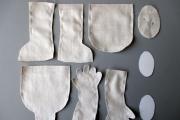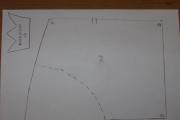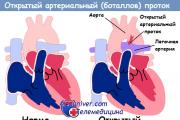How to know if you have enough breast milk. How to correctly determine whether a baby has enough breast milk: useful recommendations and myths
No one can doubt the benefits anymore breastfeeding. The World Health Organization encourages exclusive breastfeeding until 6 months of age and continued breastfeeding until 2 years of age or beyond. However, many women still continue to doubt own capabilities breastfeed your baby. This is due to old Soviet stereotypes about the feeding regime, the timing of the introduction of complementary foods and the amount mother's milk, necessary for the baby one feeding every month of life.
Meanwhile, we must not forget that each child develops individually and his food needs may not coincide with the recommended routine standards prescribed in “smart books.”
This article is about how to understand your baby and be calm about the fact that your baby is getting enough breast milk.
How to determine the amount of milk required for a baby
When the baby is artificial, he is offered a certain amount of formula at certain intervals. The recommended volume of formula is calculated according to the age and weight of the child. On average, up to 6 months a newborn needs a volume of nutrition that is equal to 1/6 of his body weight. This rule applies to both artificial and breastfeeding. But one child simply won’t eat that much, and another won’t drink even half of his portion. So on breastfeeding.
It turns out that there are standards, but not all children fulfill them. It is almost impossible to accurately determine the amount of mother's milk that a newborn will need per feeding. It is only known that different children drink from 700 to 1200 ml per day. Moreover, the daily volume of milk both in the 2nd and 5th months may not differ much, but the child’s weight will still increase. This happens because the composition human milk changes every day to meet the individual needs of a growing baby.
Weighing the baby before and after feeding - objective way monitoring effective breastfeeding
How to determine the amount of milk your baby drinks
If a nursing mother is haunted by the question of how much milk her baby is getting, she can carry out a control weighing. To do this, immediately before feeding, the baby is weighed on a special electronic baby scale. He is then fed and weighed again. The difference in weight will reflect the amount of food eaten.
Important! The newborn must be dressed in the same clothes before and after feeding, otherwise the result will be unreliable.
A baby can suck 50 ml of milk at one feeding, and 150 ml at another. This is quite normal, but only if the baby is fed on demand at intervals of 2 - 3 hours and is not given any other liquid.
By summing up the numbers of all feedings per day, we get the daily amount of milk the child drinks, which is 700 - 1200 ml.
How to find out if your baby has enough milk
In order to determine whether the baby has enough breast milk, it is necessary to completely give up breast milk for one day. disposable diapers. This is done so that the mother can control the amount of urination of the baby. Children who are exclusively breastfed and not receiving any other liquid should urinate at least 12 times a day from 2 weeks to 6 months of age. This is the most main indicator that the baby has enough milk.
But there are also other criteria by which you can find out that the baby is receiving breast milk in sufficient quantities:
- Periods of sleep, wakefulness and play significantly exceed periods of crying.
- The baby's skin is pink and elastic.
- The skin around the fontanel does not fall in.
- The baby's eyes are shiny and tears are released when crying.
- Weight gain of at least 125 - 150 g per week.
- At least 12 urinations per day.
If all these indicators are positive, then the baby will definitely eat up his mother’s milk.

The main criterion for adequate feeding of the baby is normal monthly increase in bulk
Signs of low breast milk
When a baby doesn't get enough breast milk, he doesn't gain weight and becomes restless. In addition, the mother may notice that the baby, while feeding, tears away from the breast with a cry, and then picks it up again. The situation may repeat itself several times. This behavior of the child can be provoked by colic or poor milk flow, and not by its lack, so it is necessary to find the real reason baby's worries.
The number of urinations performed by babies will indicate the sufficiency or lack of milk. This is perhaps the most important criterion that you need to pay attention to. But the frequency of stool has nothing to do with the amount of milk.
If the child frequent crying without tears and a sunken fontanelle, then you need to urgently consult a doctor, as this may be one of the signs of dehydration.
In conclusion, I would like to reassure young mothers. Women who really cannot provide for their baby breast milk, only 2%. It is clear that a mother who loves her baby will be constantly concerned about his nutrition and health. Fearing that the child is malnourished and doubting the amount of breast milk is a problem for all nursing mothers without exception. To overcome these problems, you need self-confidence, taking care of your health and nutrition, proper rest, and sleeping together with your child. And our advice will help you correctly understand and solve any problem.
"Does my baby have enough milk?" - a question that worries many mothers. Pediatricians with growth charts, grandmothers with their memories, friends with very different experiences - everyone is interested in the baby’s weight and behavior, and now the mother begins to worry...
Exact sign
There is only one sign that reliably tells whether there is enough milk or not: good increase in weight. According to standards World Organization Health care, infants should gain at least 125 g per week for the first few months of life. Note that a newborn’s weight gain in the first month is calculated not from the body weight at birth, but from the minimum weight, because in the first few days of life the baby often loses up to 10% of the weight with which it was born. This phenomenon is absolutely normal, but the lost 200-300 g are also returned not by themselves, but by mother’s milk!
When calculating increments, there is usually no need to weigh the child more than once a week. And the “control feedings” that doctors of the “old Soviet school” loved so much do not give any idea at all about the amount of milk a mother has - on the contrary, Too frequent weighings make both mother and baby nervous, just because of the weighings themselves, the baby may suck less, and the mother’s milk production may be worse. It is quite enough to do this once a week, at about the same time, and you need to weigh the baby naked or in a just put on dry diaper (a thoroughly soaked diaper or diaper can weigh up to 250 grams).
Well, in order for the mother to be able to navigate the situation every day, you can conduct a “wet diaper test,” that is, count how many times the baby pees. For a child older than a week from the family thatreceives exclusively mother's breasts, without additional feeding or additional feeding of anything, the number of "pees" less than 8 times a day can make you think about insufficient milk supply.If the number of urinations per day is 8 or more, then the baby has enough milk, although, most likely, it makes sense to offer the breast more often. Well, when a baby urinates 12 or more times, then, as a rule, this indicates that there is a very good weight gain and, accordingly, there is no need to worry about the amount of milk!
Unreliable signs
And yet, most mothers begin to worry about the lack of milk, without focusing on the baby’s growth. A study conducted by Russian doctors in Astrakhan (A.A. Dzhumagaziev et al., 2004) showed that the most common cause When starting to use formula - 50% of all cases - mothers considered it a “lack of milk”. However, an in-depth analysis found that this “diagnosis” was justified in only 2.4% of cases. Usually mothers take the following as signs of lack of milk...
Mom stops feeling hot flashes . Most mothers (although not all) feel a rapid and strong filling of the breast with milk only in the first few weeks after childbirth, when the new hormonal status of the body has not yet become established. At this time, milk arrives sharply and immediately in large quantities, and after the so-called establishment of lactation, the body adapts to the child’s needs, and milk begins to arrive little by little, but constantly. As a result of the establishment of lactation, the breasts seem smaller and softer than they were just recently, but this is not due to changes in the amount of milk produced, but simply due to the absence of previous sharp hot flashes! The very feeling “my breasts are soft and seem empty” does not say anything about the amount of milk - while the baby sucks and swallows, there is milk in the breast, even if it seems to you that this is not so: it’s not about the milk at all, you just have an established lactation.
Mom can pump just a little . The breast is not a bottle; it does not show exactly how much milk the baby has sucked. Some mothers, worried about this, try to express milk just to understand how much there is. But the amount that you manage to express, even if it’s one tablespoon, means nothing. Breast pumps are different, many models simply do not work well enough in principle or for some breast characteristics; and you need to be able to pump effectively by hand. And the most important thing: no breast pump and no hands alone can extract milk as well as a properly attached baby can suck it out! The breast and the child were originally intended for each other; everything else remains an imitation.
The baby often asks for the breast and sucks for a long time . There is no one-size-fits-all rule for how often or how long a baby should feed. The child asks his mother to give him the breast whenever something bothers him! This “something” may be hunger, but hunger is not the only or even main reason for the baby's anxiety. The baby may remember the stress of childbirth, he may be bothered by pain in the tummy, or his head may hurt due to changes in atmospheric pressure and changes in weather. And since mother’s breast is the calmest and cozy place in the world, then in all these cases the child will begin to give signs that he wants to suck: he turns his head from side to side, pulls his hands towards his mouth, opens his mouth, even smacks his lips... And the child sucks exactly as much as he needs to calm down. When the discomfort is slight, then a couple of minutes may be enough, during which the baby will suck only 5-10 ml, which is necessary simply to achieve comfort and get the feeling that he is loved by his mother and his mother accepts him. And other times the baby may be at the breast for a very long time; Many babies love to sleep under the breast while sucking, and this is completely natural for a baby! If the baby is constantly “hanging” on the chest, this also speaks not so much about the amount of milk (everything may be fine with him!) but about the quality of the latch. Unfortunately, with a shallow or incorrect attachment to the breast, the baby needs much more time to receive the portion of milk necessary for saturation, although there may be enough of it in the breast. In cases where the baby sucks for a long time and often - for example,feeding durationabout an hour with breaks, also about an hour, and so on constantly - it is necessary for the situation to be assessed by an experienced lactation consultant, since it is precisely this behavior that often indicates improper latching. The consequence is a decrease in the amount of milk that the baby is able to receive from the breast, even if there is quite enough of it there.
Baby screams after feeding . Sometimes, indeed, the baby can suck for a long time and not get enough - especially, as we have already said, in the case of not correct application to the breast, when it is difficult for the baby to effectively produce milk. But there are many other reasons for this behavior: it could be colic, or teething, or a desire to stay with mom longer, or even get a pacifier if mom gives it often. Based on such behavior alone, one cannot conclude that there is a lack of milk!
Baby arches at the chest . But this behavioral feature is usually associated with the flow of milk. Newborns often behave this way because there is a strong flow of milk that they cannot handle. And in older babies, “bending” most often means that the flow of milk is weakening, and the child would like a more active flow. In the first weeks of life, babies in such cases simply fall asleep at the breast, but a few months later - especially if they have experience sucking a pacifier or bottle - the baby begins to express his dissatisfaction with “bending” or scandals. The amount of milk has not changed, the baby has changed!
What to do?
But suppose the mother received strong confirmation of her opinion about the lack of milk. What to do if there really is less of it than the baby needs? Don’t rush to supplement with formula! Lactation is a hormone-dependent process. The hormone prolactin, which is responsible for milk production, is produced in response to breast stimulation. This means that the amount of milk can vary either less or more depending on your baby's sucking behavior. And in order for the baby to have enough milk, by and large it is enough to follow only four principles (they are arranged in order of importance):
Attach your baby to the breast correctly . This is important not only for the baby, but also for the mother, since if applied incorrectly, the baby can damage the breast (which is why cracks occur). Feeding with improper attachment is often ineffective: the baby does not receive enough milk, although he can suck a lot and for a long time. The correct attachment is influenced by the use of a pacifier and a bottle, since the very principle of sucking a nipple and a breast is different! No matter what “orthodontic” shape the nipple has, nothing can change the simple fact that to suck the breast the child needs to open his mouth wide and actively work with the lower jaw (this is the only way milk is extracted from the breast), and to suck the nipple it is enough to open his mouth slightly and make suction movements with your cheeks. And the feel of a mother’s soft breast is very different from the hard silicone nipple, which implies a different degree of impact. Very often, a child who is accustomed to sucking a pacifier begins to latch onto the breast incorrectly and suckle poorly! Therefore, if the baby needs to be given medicine or supplementary feeding, it is better to do this from a cup, spoon, pipette or other supplementary feeding devices, in addition to a bottle nipple; video about in various ways supplementary feeding, in addition to the pacifier, you can look .
 To get your baby to breastfeed well, try doing this. Press the baby's tummy firmly against you so that the nipple is approximately at the level of the nose. Support your chest with your hand so that thumb was on top, and the index and others were on the bottom, parallel to the child’s lower lip. Index finger should be far from the nipple, no closer than 5 centimeters, so it will not limit the opening of the baby’s mouth. Wait until the baby opens his mouth wide and point the nipple up towards the sky. The nipple and areola should be deep in the mouth, more from below than from above. The lower and upper lips turn outward when sucking. When feeding, the baby's head is directed upward, the chin is pressed to the mother's breast, and the nose either touches it with the very tip or is completely free. You can watch very detailed animated videos about correct application ,
and a video of correct application -
.
To get your baby to breastfeed well, try doing this. Press the baby's tummy firmly against you so that the nipple is approximately at the level of the nose. Support your chest with your hand so that thumb was on top, and the index and others were on the bottom, parallel to the child’s lower lip. Index finger should be far from the nipple, no closer than 5 centimeters, so it will not limit the opening of the baby’s mouth. Wait until the baby opens his mouth wide and point the nipple up towards the sky. The nipple and areola should be deep in the mouth, more from below than from above. The lower and upper lips turn outward when sucking. When feeding, the baby's head is directed upward, the chin is pressed to the mother's breast, and the nose either touches it with the very tip or is completely free. You can watch very detailed animated videos about correct application ,
and a video of correct application -
.
A baby who is well attached sucks out fairly large volumes of milk during feeding. Moreover, this also applies to cases when the baby falls asleep under the breast - children have a unique ability to eat fully in their sleep! You can verify this if you observe the characteristic way of sucking of a baby who receives milk (and does not just hold the mother’s breast in his mouth): when the baby’s mouth opens as much as possible, then before its jaws move again, the baby’s chin lingers. This “hanging” of the chin means a sip of milk. This can also be noticed by the swallowing movement of the neck, but in some feeding positions it is difficult for the mother to monitor the neck, but tracking the pause between sucking movements is quite simple. good selection videos about attachment and supplementary feeding options, where you can look at the features of good and not so good attachment.
Some mothers believe that such pauses indicate that the milk in that breast has already run out. Just the opposite! A baby who suckled at the breast with pauses of 15-20 minutes may be very full at the end of feeding, but if the baby just sucked without swallowing, then even two hours may not be enough for him to eat.
Feed your baby on demand. The main advantage of feeding on demand, which a mother who feeds her baby according to a schedule can never be sure of, is the knowledge that the child is really , and that he is in a state of greatest psychological comfort that is currently available to him. The same baby can suckle with completely different frequencies in different times their lives, because children grow unevenly, and their life circumstances are different. At any time, the baby may unexpectedly demand more frequent feeding for several days, which will correspondingly cause an increase in milk supply. Children are great at regulating their needs if you allow them to control the situation. Of course, feeding on demand assumes that the mother gives the breast, and nothing but the breast (no nipples, water or other liquids)!
An important point is that feeding on demand can also mean the mother’s demand. The mother does not have to wait every time until the baby shows interest in feeding; she can offer the breast and own initiative. For example, the baby has fallen asleep and has not breastfed for 3-4 hours, and the mother’s breasts are already overflowing with milk. Or the mother needs to go somewhere, but before going out she wants to feed the child. Or the mother has stagnation of milk, and she needs the baby’s help to dissolve the lump. Finally, if the “wet diaper test” shows results from 8 to 12 times a day, then the mother should sometimes offer the breast herself so that the baby gets more milk.
Feed at night . The hormone prolactin is a “night” hormone: stimulation of the mother’s breasts from 3 to 8 am causes its maximum production. Therefore, at night the baby eats and “regulates” the amount of milk from the mother. Usually healthy child, who is not bothered by anything, wakes up two or three times between 3 and 8 in the morning to kiss his mother’s breast. A mother who underfeeds her baby at night usually notices quite quickly that by the evening there is not enough milk... In in case of emergency, when the baby himself does not wake up the mother for night feedings, you literally have to set an alarm clock to “save milk.” Co-sleeping with a baby or sleeping in a crib as close as possible to the parent’s has helped many mothers cope not only with their lack of sleep at night, but also with the problem of lack of milk.
Well relax . If milk production itself is associated with the hormone prolactin, then its release is associated with the hormone oxytocin. When mom is in a constant state of anxiety, the oxytocin response is suppressed by stress hormones. This means that there may even be a lot of milk, but it is poorly released from the breast; It is this condition that is usually called “the milk has disappeared from the nerves.” In fact, it does not “disappear”, but in a nervous mother it is much more difficult for the baby to suck it out. Therefore, it is important for a nursing mother to be able to relax during feeding, get good sleep and be less nervous!
These four principles play a major role in maintaining lactation. If at least one of them is not observed, problems may arise with the amount of milk. There are many “folk” ways to maintain milk production, but most of them have no basis, and the rest will give very little effect without following the basic principles. But they can be used as auxiliary ones.
Pumping can be used to gradually replace formula supplementation with breast milk. In this case, the mother expresses her breasts several times a day (in addition to feeding, if she is with the baby, or instead of feeding, if they are separated), stimulating the breasts for additional milk production and.
It will be great if, if additional feeding is necessary, it is given to the baby throughsystem for supplementary feeding at the breast- it is a container into which supplementary feeding is poured, and from where two extremely thin capillaries emerge, one of which is inserted into the baby’s mouth to ensure a constant supply of nutrition while sucking the breast. Even if the breast is completely empty, when using such a system, the baby will receive nutrition precisely through sucking - and, unlike other methods of supplementary feeding, this allows you not only to feed the baby, but also to stimulate the breast to increase the production of its own milk! In the videos linked above, you can look at supplementary feeding using such a system.
Skin to skin contact , that is, often carried in the arms or in a sling, and placing the baby on your stomach stimulates both lactation and good development baby. This is especially useful if the baby is restless under the breast.
Lactogonic agents on different mothers have different effects. Western doctors and consultants believe effective use fenugreek herbs and seeds (also known as shamballa and fenugreek) - you can usually buy it in the spice department; By the way, fenugreek is included in many mixtures sold under the name “curry”; its content in such a mixture can reach 20%. . But in general the recipeswhich are widely circulated among the people, are not effective for everyone - and sometimes, unfortunately, they also cause allergic reaction at the baby's. And, in particular, such a popular remedy as hot tea activates the flow of milk, but does not in any way increase its total quantity.
The main thing to remember is that if the mother wishes, any problem can be solved. Lactation consultants help transition babies to breastfeeding even if they receive little or no breast milk. Just don't hesitate to ask for advice!
Author , photos were used in the design of the article Olga Ermolaeva
There are many signs by which nursing mothers try to determine whether their baby is getting enough breast milk. But how do you understand which criteria are reliable and which you shouldn’t rely on? Breastfeeding specialists note signs that indicate that breast milk is sufficient for the baby.
The main signs that there is enough milk
Experts consider weight gain and the amount of urine produced to be the most informative and reliable criteria for the sufficiency of breast milk. The child should urinate at least 6-8 times a day. In this case, we can say with confidence that the baby has enough breast milk. Urine should be light yellow, almost colorless and have a slight odor. This means that the baby receives through breast milk sufficient quantity liquids.
In the first two weeks of life, the baby should regain its original weight. Then every month for six months he gains at least 500 g. It is better to do control weighing once every two weeks.
Focus on how often you change your diaper. If this happens at least four times a day and the diapers are full, then everything is fine. To accurately count the number of urinations, you can stop using diapers for a day and conduct a wet diaper test.
Additional criteria
There are also a number presumptive signs milk sufficiency:
- calm behavior of the child after feeding;
- regular intervals between feedings;
- normal stool.
If after feeding the baby does not show signs of anxiety and falls asleep sweetly, then he is full. Long intervals between feedings also indicate that the baby is full. It is believed that if the baby does not ask for breastfeeding for 1.5-2 hours, then everything is fine with the amount of milk.
But don’t panic if your baby demands the breast more often. The reason may be not only a feeling of hunger, but also discomfort in the tummy, the need for affection and protection, the desire to be in the arms of the mother.
Pediatricians and breastfeeding specialists recommend putting your baby to the breast on demand. This should be done even if you are sure that the cause of your baby’s anxiety is not caused by hunger. In addition, frequent feeding is beneficial for normal lactation.
Monitor your baby's normal bowel movements. A newborn's stool should be yellow, uniform, and smell like sour milk. The frequency of bowel movements is different for all babies. Some babies soil their diaper after almost every feeding. And it happens that bowel movements occur once every few days. This is also the norm, provided that when emptying the baby does not experience pain, he is not bothered by colic, he is gaining weight normally.
With a lack of milk, the stool is darker in color, it can be greenish or brownish, and has a dense consistency.
False signs of low milk supply
Quite often, a nursing mother believes that she does not have enough milk, based on unfounded facts:
- lack of feeling of breast fullness;
- long or frequent sucking by the baby;
- discomfort of the child during feeding;
- small amount of milk when expressing.
For most women, it is quite normal not to feel heaviness and fullness in the breasts after 1-2 weeks after the start of lactation. The body adapts to milk production and the baby's needs, and you stop feeling discomfort. But this does not mean at all that milk has become scarce.
There are no rules or regulations for how long a baby should spend near the breast. Some children are sated in 10 minutes, others need half an hour. The child chooses the number of attachments and sucking time. Do not panic if the baby often asks for the breast, this does not mean that he is not getting enough. Just follow your baby's wishes and feed on demand.
After 4-6 weeks, many children begin to feel nervous near the chest: arching, crying. The mother begins to feel that the baby is feeling discomfort due to lack of milk. But that's not true. In the first weeks, babies often abandon the breast and fall asleep when the milk flow becomes weaker, even if they are not yet full. But at an older age, the child no longer wants to fall asleep until he is full. Just squeeze your breasts a little to increase the flow of milk, and in the future the baby will learn to suckle more actively and the process will improve again.
Like all young mothers, at one time I was worried about the question: how to understand that there is not enough milk? I know a few rules, and I'll tell you. We will also look at how to identify false signs of lack of milk, so as not to be needlessly upset. And of course, in case insufficient lactation Don’t give up, I’ll tell you a proven way to improve lactation.
Features of adequate feeding
A mistake many mothers make is pumping to determine the volume of breast milk. This is not worth doing, because it is impossible to fully express your breasts on your own. It is possible to determine whether the baby has enough food only by observing him. It is impossible to answer the question of how long you need to feed a child so that he gets enough. It all depends on individual characteristics baby's body. A newborn should be fed on demand; he will not eat too much. The number of attachments sometimes reaches 25-30 times a day, this is natural, because the baby feels warm and comfortable next to his mother.
But still, there are several signs that will help determine whether the baby is eating:
1. Number of applications.
In the first 2 weeks of life, a newborn requires breastfeeding 8-15 times a day. In this case, the minimum interval is 1 hour. This is because the stomach is too small to eat more milk. It should be borne in mind that mother's milk is quickly absorbed, and children's body constantly demands nutrients for full growth and development.
2. Duration of sucking.
Moms, never take your newborn off the breast, even if you think he is sleeping. You just have to wait a little and the baby will release the nipple on its own. The baby can eat in his sleep, so tearing it away from the nipple can leave the baby hungry.
3. The newborn swallows while sucking.
If there is enough milk, the mother should clearly hear the baby swallowing. Moreover, in the first 2-3 minutes the newborn sucks a little and often swallows, and the rest of the time he has to make an effort, because the milk becomes quite thick.
4. Normal set weight.
It is necessary to weigh a newborn from the 5th day of life; in the first days, children only lose weight. Then weight gain is normal from 120-220 grams per week. Of course, it all depends on individual characteristics. It is important to note that children born weighing up to 2.5 kg gain 100-150 grams per week in the first month.
5. Healthy looking newborn
Of course, this is the main proof of sufficient nutrition. Sleep should be replaced by wakefulness in a timely manner, and the baby should demand to eat. If the baby releases the nipple on his own after feeding and soon falls asleep, it means he is full.
It is worth highlighting one more method that helps determine whether the baby is eating enough. Mommy should notice how many times a day her baby goes to the toilet. If you have to change the described diaper 5-6 times a day, you can calm down, the newborn is full. A breastfed baby may poop 2-5 times a day. But sometimes there are no bowel movements for up to 2 days, and this is not considered a pathology.
Normally, feces should be yellow with a granular structure, green feces may report lactose intolerance. This method is only suitable if the baby is not receiving additional formula or water. You now know how to know that a newborn is not getting enough food. We have to look at false signs of insufficient lactation.
False signs of lack of lactation
False signs lack of milk can frighten any mother. What to do if there is no congestion in the chest, and the baby begins to eat in only 5 minutes instead of the usual 15 minutes? It is simply necessary to consider them.
No chest congestion.
As a rule, a nursing mother stops feeling hot flashes after a month of feeding. And this is not bad at all, and of course does not mean that the amount of milk has decreased. On the contrary, this is the first sign that you have managed to establish lactation.
Increased appetite in a child
Many mothers think that if the baby often demands to eat, it means they have little milk. This is not true, there is certain periods development of the baby, when his body requires a larger volume of food. At this moment, the baby “hangs” on the chest for 20-30 minutes, every 2 hours.
How to increase lactation?
If you realize that the baby does not have enough food, do not rush to give up breastfeeding. There are several tips that will help increase lactation in just a few days. Remember that lack of milk is not a reason to supplement your newborn with formula. The first thing to do is to put the baby to the breast as often as possible; the baby's sucking stimulates milk production in larger volume.
What to do:
- Both breasts should be offered to the baby at each feeding.
- It is necessary to ensure that the baby grasps not only the nipple, but also the areola, this will ensure more effective sucking.
- When the baby stops swallowing milk, you need to change breasts.
- It is necessary to give up pacifiers and pacifiers. If you need to supplement your baby with formula, it should be given from a spoon.
- Equally important is the mother's peace of mind. The child feels the mother's mood.
- Complete and timely rest.
Taisiya Lipina
Reading time: 5 minutes
A A
Mother's milk has no competitors in terms of benefits for the health and development of the baby, protecting it from allergies and diseases. Replacing breast milk with even the best adapted milk formula is justified only if the mother is absolutely “non-dairy.” In other cases, lactation can and should be fought for. But first you need to determine whether there really is not enough milk.
How can you tell if your baby is not getting enough breast milk?
A young mother’s worries about a lack of milk are most often groundless: nature perfectly adapts female body to the child's needs. First check if your doubts are valid.
Signs of malnutrition in infants can be divided into reliable ones, which clearly indicate a lack of milk, and relative ones, which may be symptoms of other painful conditions.
Assess the situation comprehensively : 1-2 identified signs are not yet a reason to buy the mixture.
Reliable methods:
- Small weight gain or loss
If you have electronic scales at home, you need to determine the difference before and after each feeding, and then calculate the total volume of milk consumed per day. The norms are as follows: from 10 days to 2 months - a fifth of body weight, from 2 to 4 months - a sixth.
Worth considering
Breastfed babies may eat at different feedings or even days. different quantities milk, so it is more objective to assess weight gain per week. Breastfeeding consultants claim that if a baby has “ate” at least 125 g in a week, then this is quite enough and the baby has enough milk.
However, constant weighing can make the mother even more nervous, so it is better to determine the increase at control weighings when visiting the pediatrician once a month, especially if the child’s overall health is good, he is growing and developing normally.
- Insufficient urination
Give up disposable diapers for a day and carry out a “wet diaper test” within 24 hours - up to 2 months there should be ten or more of them, then six or more, the size of wet spots is no smaller than a regular plate, urination should not cause concern or painful sensations, and the color of the urine should be pale yellow.
If there is no desire or opportunity to bother with swaddling
Relative:
- Frequent and demanding crying (it is also called hungry) - this cry is easy to distinguish from whining, when the child is simply bored and asks for attention. Mom will need to become a real virtuoso in assessing the different intonations of crying.
- Long feedings . All babies have their own rate of milk absorption.
- Lethargy or restlessness, sleep disturbances . May indicate insufficient rest, overstimulation from active games or the onset of the disease.
- Sharp excitement when approaching or smelling the mother . The baby may simply ask for communication.
- Sucking a finger, the edge of a diaper or blanket . The baby may also be teething or feedings are not frequent enough, and he does not have time to satisfy the sucking reflex.
- Excessive dry skin . Milk for babies – not only delicious food, but also a life-giving source of quenching thirst. However, dryness is possible due to a lack of certain vitamins or excessively dry and hot air in the nursery.
- “Empty” soft breasts between feedings, small volume of expressed milk . With stable established lactation and frequent applications The baby should not experience soreness and engorgement of the mammary glands - milk flows to the breast during feeding.
















